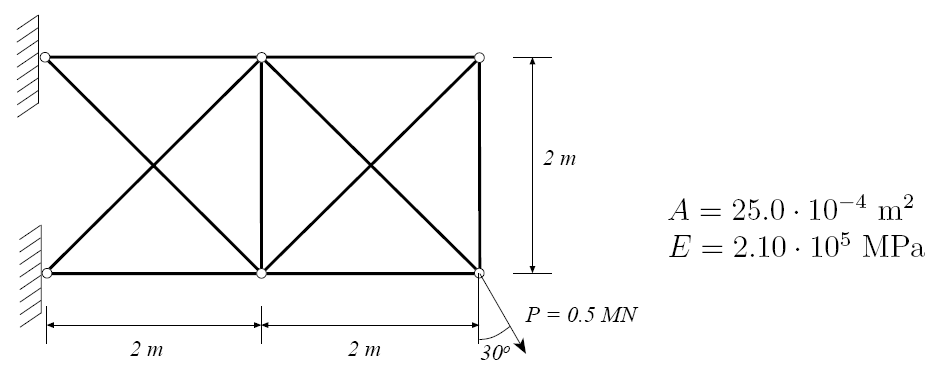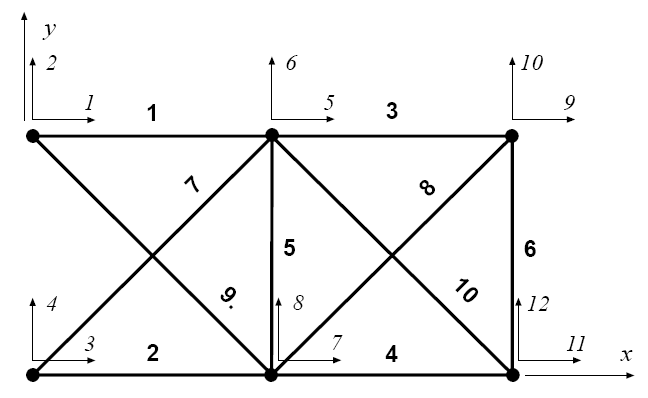Example: More bars¶
This example is from Calfem manual (exs4.py).
Purpose:
Analysis of a plane truss.
Description:
Consider a plane truss, loaded by a single force P = 0.5 MN at 30 \(^\circ\) from normal.

The corresponding finite element model consists of ten elements and twelve degrees of freedom.

First, import necessart modules.
[1]:
import numpy as np
import calfem.core as cfc
The topology is defined by the matrix
[2]:
Edof = np.array([
[1, 2, 5, 6],
[3, 4, 7, 8],
[5, 6, 9, 10],
[7, 8, 11, 12],
[7, 8, 5, 6],
[11, 12, 9, 10],
[3, 4, 5, 6],
[7, 8, 9, 10],
[1, 2, 7, 8],
[5, 6, 11, 12]
])
A global stiffness matrix K and a load vector f are defined. The load P is divided into x and y components and inserted in the load vector f.
[3]:
K = np.zeros([12,12])
f = np.zeros([12,1])
The element matrices Ke are computed by the function bar2e. These matrices are then assembled in the global stiffness matrix using the function assem.
[4]:
A = 25.0e-4
E = 2.1e11
ep = [E,A]
Element coordinates are defined as follows.
[5]:
ex = np.array([
[0., 2.],
[0., 2.],
[2., 4.],
[2., 4.],
[2., 2.],
[4., 4.],
[0., 2.],
[2., 4.],
[0., 2.],
[2., 4.]
])
ey = np.array([
[2., 2.],
[0., 0.],
[2., 2.],
[0., 0.],
[0., 2.],
[0., 2.],
[0., 2.],
[0., 2.],
[2., 0.],
[2., 0.]
])
All the element matrices are computed and assembled in the loop.
[6]:
for elx, ely, eltopo in zip(ex, ey, Edof):
Ke = cfc.bar2e(elx, ely, ep)
cfc.assem(eltopo, K, Ke)
The displacements in a and the support forces in r are computed by solving the system of equations considering the boundary conditions in bc.
[7]:
bc = np.array([1,2,3,4])
f[10]=0.5e6*np.sin(np.pi/6)
f[11]=-0.5e6*np.cos(np.pi/6)
a, r = cfc.solveq(K,f,bc)
[8]:
print("Displacement: ")
print(a)
Displacement:
[[ 0. ]
[ 0. ]
[ 0. ]
[ 0. ]
[ 0.00238453]
[-0.0044633 ]
[-0.00161181]
[-0.00419874]
[ 0.00303458]
[-0.01068377]
[-0.00165894]
[-0.01133382]]
[9]:
print("Support force: ")
print(r)
Support force:
[[-8.66025404e+05]
[ 2.40086918e+05]
[ 6.16025404e+05]
[ 1.92925784e+05]
[ 4.65661287e-10]
[-2.91038305e-11]
[ 1.16415322e-10]
[ 1.16415322e-10]
[-4.65661287e-10]
[ 3.49245965e-10]
[-2.03726813e-10]
[ 4.65661287e-10]]
The displacement at the point of loading is \(−1.7 · 10^{−3} m\) in the x-direction and \(−11.3 · 10^{−3} ~m\) in the y-direction. At the upper support the horizontal force is \(−0.866~MN\) and the vertical \(0.240 ~MN\). At the lower support the forces are \(0.616~MN\) and \(0.193~MN\), respectively. Normal forces are evaluated from element displacements. These are obtained from the global displacements a using the function extract. The normal forces are evaluated
using the function bar2s.
[10]:
ed = cfc.extractEldisp(Edof,a)
N = np.zeros([Edof.shape[0]])
print("Element forces:")
i = 0
for elx, ely, eld in zip(ex, ey, ed):
N[i] = cfc.bar2s(elx, ely, ep, eld)
print("N%d = %g" % (i+1,N[i]))
i+=1
Element forces:
N1 = 625938
N2 = -423100
N3 = 170640
N4 = -12372.8
N5 = -69447
N6 = 170640
N7 = -272838
N8 = -241321
N9 = 339534
N10 = 371051
The largest normal force N = 0.626 MN is obtained in element 1 and is equivalent to a normal stress σ = 250 MPa.
To reduce the quantity of input data, the element coordinates matrices Ex and Ey can alternatively be created from a global coordinate matrix Coord and a global topology matrix Dof using the function coordxtr, i.e.
[12]:
Coord = np.array([
[0, 2],
[0, 0],
[2, 2],
[2, 0],
[4, 2],
[4, 0]
])
[14]:
Dof = np.array([
[1, 2],
[3, 4],
[5, 6],
[7, 8],
[9, 10],
[11, 12]
])
[17]:
ex, ey = cfc.coordxtr(Edof, Coord, Dof)
[18]:
print(ex)
[18]:
array([[0., 2.],
[0., 2.],
[2., 4.],
[2., 4.],
[2., 2.],
[4., 4.],
[0., 2.],
[2., 4.],
[0., 2.],
[2., 4.]])
[19]:
print(ey)
[19]:
array([[2., 2.],
[0., 0.],
[2., 2.],
[0., 0.],
[0., 2.],
[0., 2.],
[0., 2.],
[0., 2.],
[2., 0.],
[2., 0.]])
As can be seen above, ex and ey is same as previous.